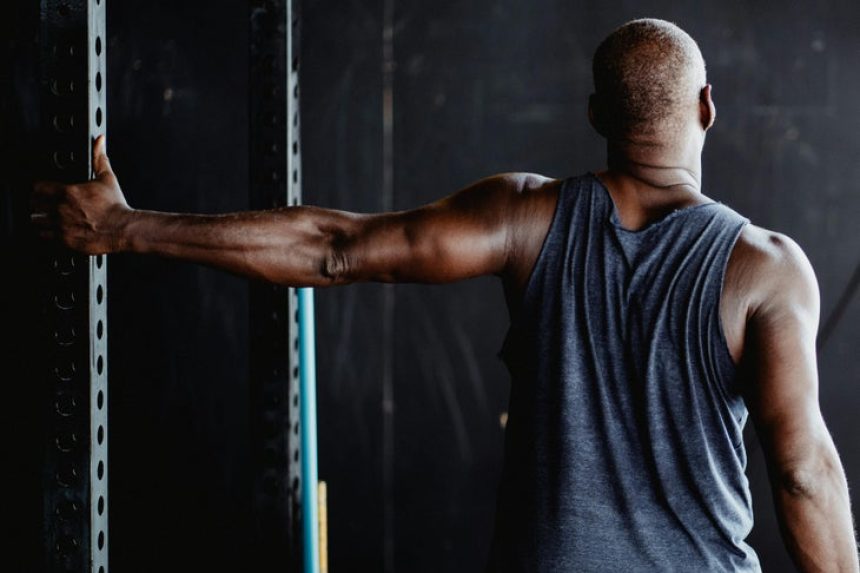“], “filter”: { “nextExceptions”: “img, blockquote, div”, “nextContainsExceptions”: “img, blockquote, a.btn, a.o-button”} }”>
Heading out the door? Read this article on the new Outside+ app available now on iOS devices for members!
>”,”name”:”in-content-cta”,”type”:”link”}}”>Download the app.
I work with athletes and non-athletes of all sorts in my role as a personal trainer and yoga teacher and one of the most common complaints I hear is nagging stiffness and soreness in the upper back. Whether the ache is from an old injury or the cumulative effects of poor posture, what everyone wants to know is essentially the same—which stretches for upper back pain will bring relief?
Can Stretching Help Upper Back Pain?
Several studies have found that practicing upper back stretches can decrease pain and increase range of motion in those who experience tightness and/or weakness in the muscles of the neck, shoulders, and upper back. Additional research suggests stretching for just 10 minutes a day with simple yoga poses can reduce upper back pain.
Upper back aches are often caused by poor posture, which is often associated with an imbalance in the strength of the muscles on the front body compared to the back body. When you engage in full-body stretching and strengthening, such as in yoga, you target various other weak muscles, including the core, that may also contribute to poor posture. You’re essentially cultivating relief from both immediate and long-term upper back pain by including yoga in your stretching routine.
What to Target With Stretches for Upper Back Pain
When you experience a vague aching in your upper back and aren’t certain where to start, focus on the following muscles:
- upper back muscles and stabilizers (trapezius, levator scapulae, latissimus dorsi, rhomboids, and erector spinae)
- shoulder muscles (deltoids and rotator cuff muscles)
- neck muscles (cervical extensors and flexors as well as the sternocleidomastoid)
- lower back muscles (those mentioned above and the deeper multifidus)
Even when the source of your soreness or stiffness isn’t the upper back muscles, they can easily become overworked from compensating for pain, injury, or immobility in adjacent muscles. Targeting stretches that address the entire upper body can bring relief.
Upper Back Stretches for Tight Muscles
Following are some of the most effective stretches—dynamic and static—for when you experience upper back stiffness and soreness. Depending on the source of your pain or injury, stretching might be only part of the treatment plan. Consult with a physician or physical therapist if you experience upper back pain before stretching to assess your individual needs. Rest, modifying activities, and strengthening weak muscles, among other things, may also be necessary.
1. Chest Stretch
It might seem odd to suggest a chest stretch when the focus is the upper back. But upper back pain can also arise from spending hour after hour hunched forward over a keyboard or phone. This causes the muscles along your upper back to become overstretched while the muscles of the chest become tight. Stretching the pecs and related muscles along the chest can allow your shoulders to return to their usual alignment.
- Stand facing an open doorway with your arms reaching straight out to the sides like the letter T. (Or stand alongside a wall or a vertical bar at the gym.)
- Take a big step forward through the open dtttoorway with one leg. Your straightened arms should catch the sides of the doorway and be drawn slightly backward, behind the rest of your body, so you feel a stretch across your chest and shoulders. (If you’re at a wall or bar, do one arm at a time and then switch sides.)
- Make sure to keep your spine neutral by looking straight ahead and engaging your core. Stay here for about 30 seconds.
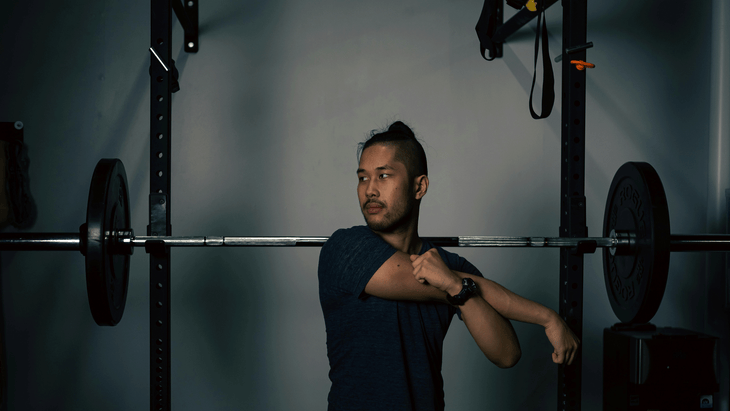
2. Trapezius Stretch
This is an easy stretch for the traps, rhomboids, and shoulders. Because you perform the stretch on one arm at a time, you can adjust the intensity for the right and left sides of the upper back muscles as needed.
- Sit or stand with good posture.
- Straighten your right arm and bring it all the way across your chest so your fingers point toward the left.
- Bring your left hand to the back of your right upper arm, just above the elbow, and draw your arm toward your chest to deepen the stretch. Hold the stretch for 20 to 30 seconds. Relax and then switch sides.
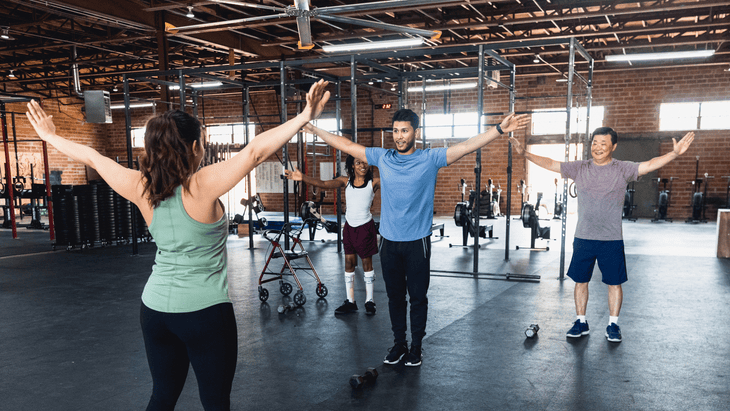
3. Arm Circles
Arm circles are a dynamic stretching exercise to warm up the upper-body muscles before doing any type of workout or if you’ve been sitting at your desk and need to loosen things up. Arm circles release not only the upper back but the chest and shoulders.
- Stand tall with your shoulders relaxed and pulled back and your chest lifted.
- Bring your arms straight out to your sides like the letter T. Keep your elbows straight as you circle your arms forward, gradually increasing the range of motion and speed, as comfortable for 15-30 seconds. Reverse direction.
- Then allow your arms to criss-cross your chest, swinging them toward your opposite shoulder, alternating which arm is on top with each swing. Repeat for 15-30 seconds.
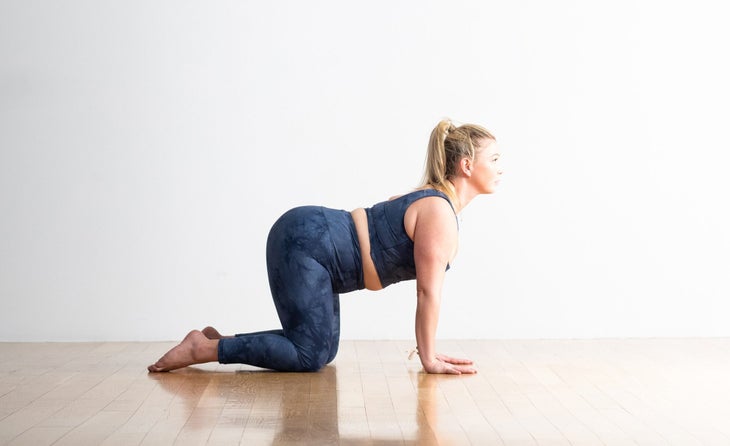 (Photo: Andrew Clark)
(Photo: Andrew Clark)
4. + 5. Cat-Cow
Cat-Cow is a dynamic stretch enhances the mobility of the spine and can be done in less than a minute or two. Try to connect the transitions between the poses with your breath to enhance your body awareness. One benefit of this is being more conscious of when you’re activating your core muscles. Engaging your core more in everyday ways can help support optimal posture, which may reduce back pain.
1. Start on your hands and knees with your hips over your knees and shoulders over your wrists. As you inhale, slowly arch your back and lower your belly toward the mat as you draw your chest and your gaze forward in Cow Pose.
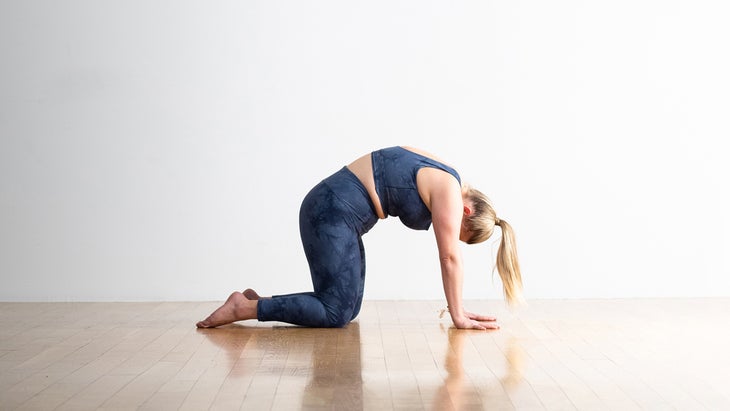
2. As you exhale, push the mat away with your hands and round your back, drawing your navel toward your spine and drawing your shoulder blades away from the spine in Cat Pose. Repeat several times. You’re welcome to incorporate any other movement here that feels comfortable, such as hip circles or figure-eights.
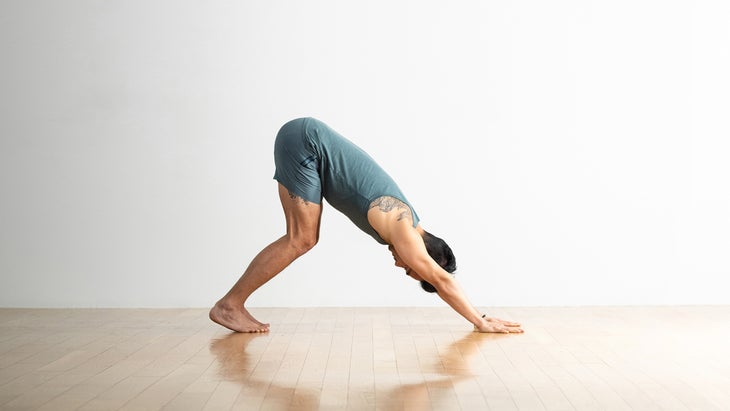
6. Downward-Facing Dog
Although this classic pose is best known for the intense stretch it brings to muscles along the backs of your legs, Down Dog (Adho Mukha Svanasana) stretches the entire posterior body, including the upper back muscles along with related muscles in the shoulders, triceps, and forearms. Remember to spread your fingers wide and press them tinto the mat, especially through the knuckles of your index fingers.
1. From kneeling, bring your hips over your knees and shoulders over your wrists. Tuck your toes and lift your hips up and back to create an upside-down V shape with your body.
2. Reach your heels toward the mat although there’s no need for them to touch. Keep a slight bend in your knees if that’s more comfortable. Then draw your shoulder blades toward your hips and lengthen through your entire spine. Keep pressing through your index fingers. Try to turn your elbow creases to face the wall in front of you. Stay here for about 30 seconds.
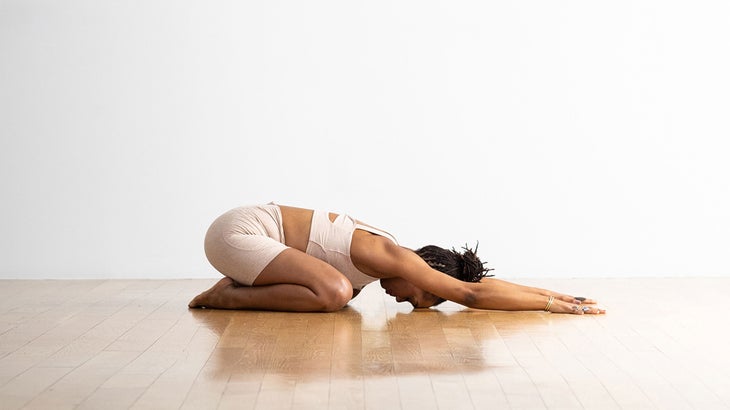
7. Child’s Pose
This yoga pose, which many find insanely soothing, is a passive stretch for the muscles of the upper back and shoulders.
1. Start kneeling with your knees wider than your hips. As you sink your hips toward your heels, reach your arms forward before lowering your chest, forehead and forearms to the mat. Try to keep the length in your spine as you release tension and allow yourself to be supported by the mat. Slow your breath and stay here for about 30 seconds.
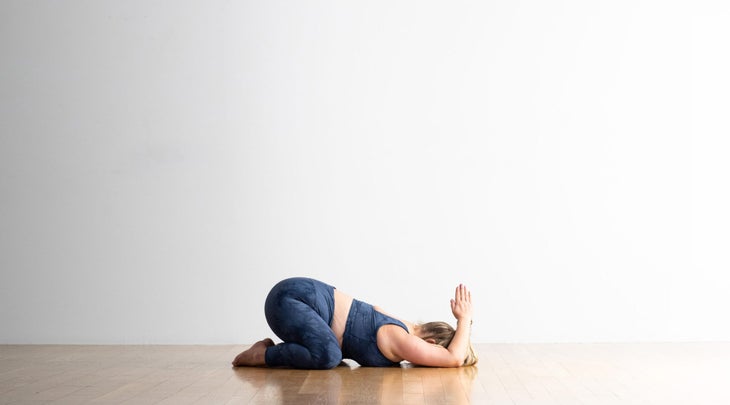
2. If you like, bring your palms together in prayer, bend your elbows, and lean your thumbs toward the back of your neck. Same stretch, slightly different sensation. Stay here for about 30 seconds.
8. Eagle Arms
The pretzel-ish pose known as Eagle (Garudasana) delivers a pretty intense stretch for the entire upper back and posterior shoulders. You can add the leg crossing if you choose, although practicing only the arms allows you to focus on the stretch without the distraction of balancing. Don’t forget to breathe.
1. From sitting or standing, keep drawing your shoulder blades down and away from your ears. Cross your right elbow over your left in front of your chest. Try to bring your palms to touch or in that general direction. Draw your shoulders down a little, away from your ears. Stay here for 15-30 seconds.
2. To intensify the stretch in your upper back, squeeze your arms together and lift your elbows slightly. Slowly unwind, shake out your arms, and repeat on the other side.

